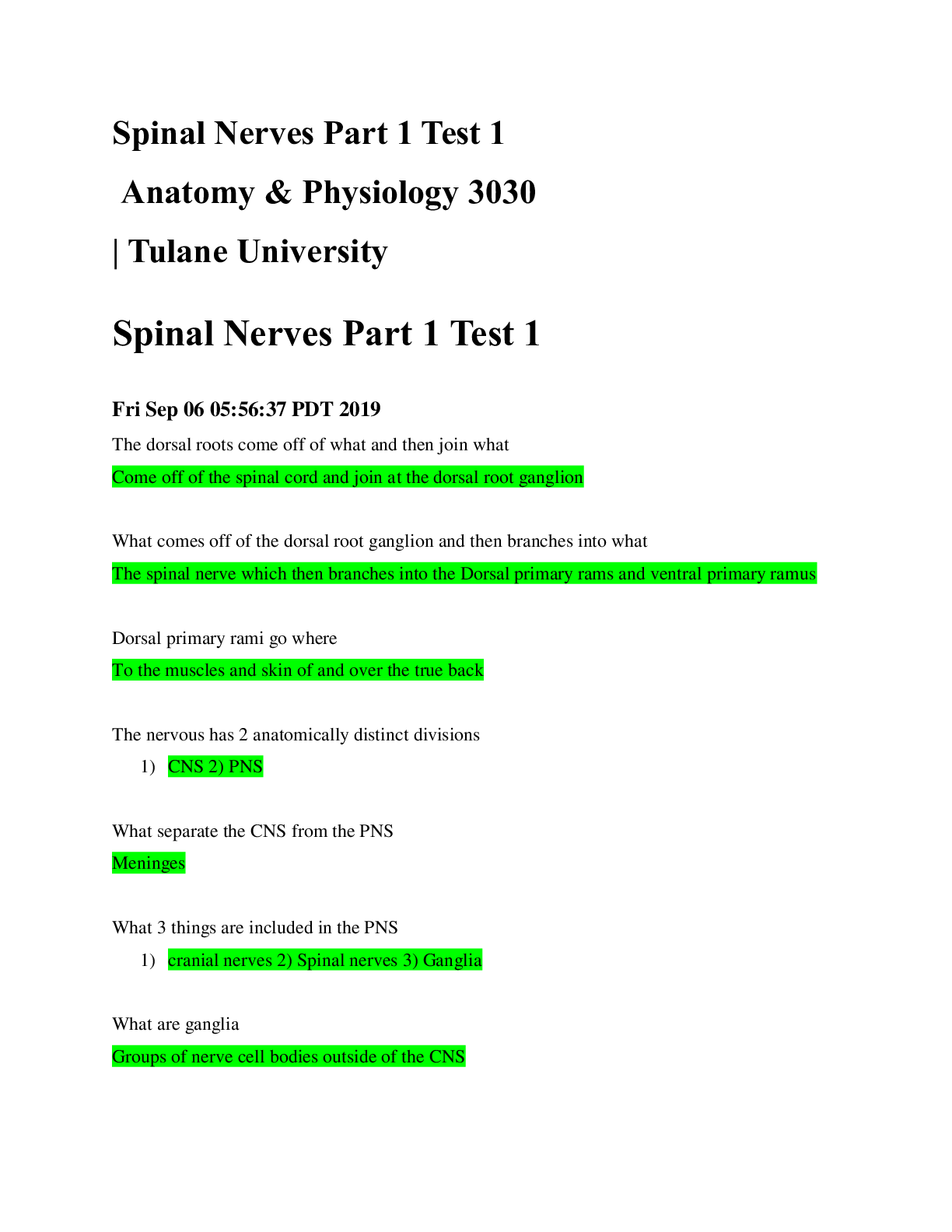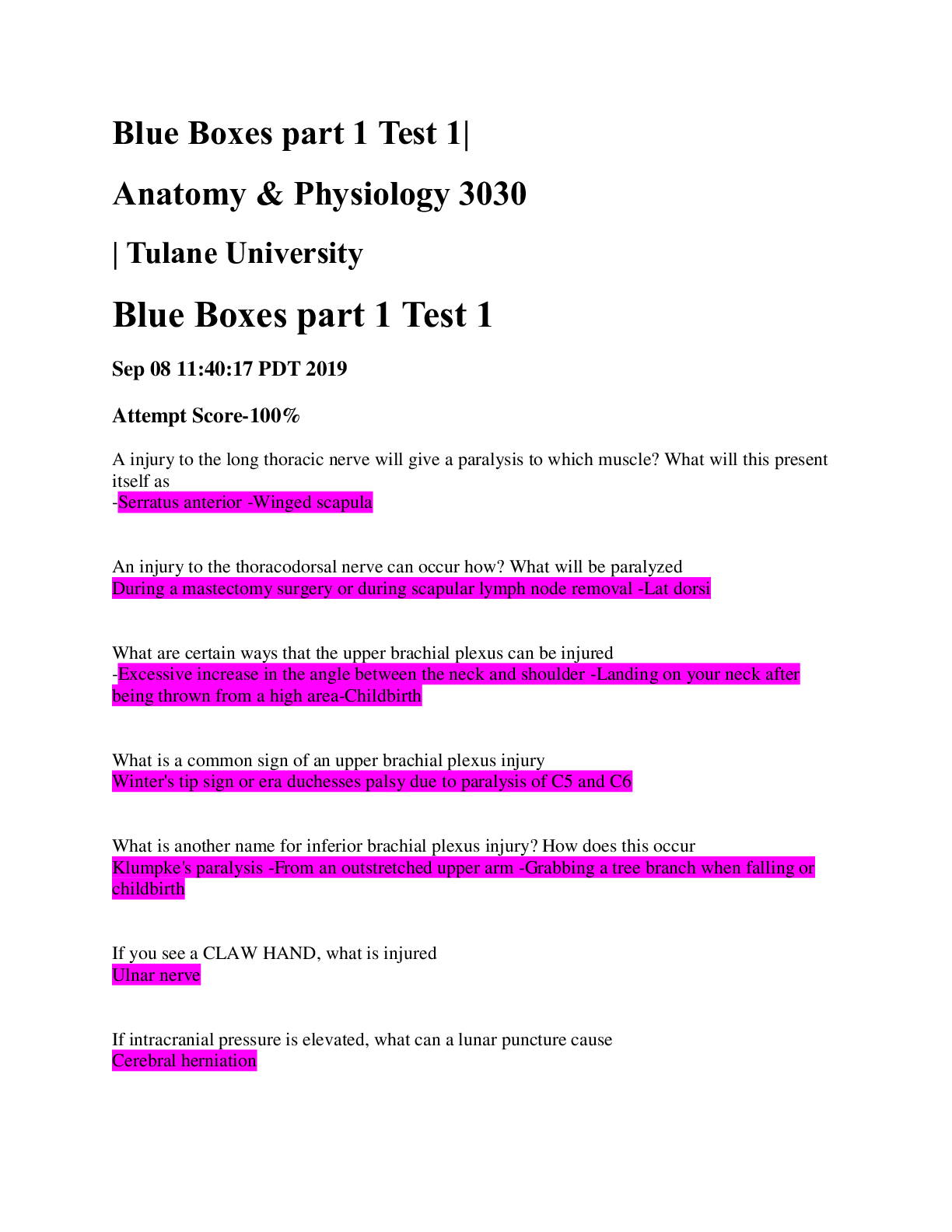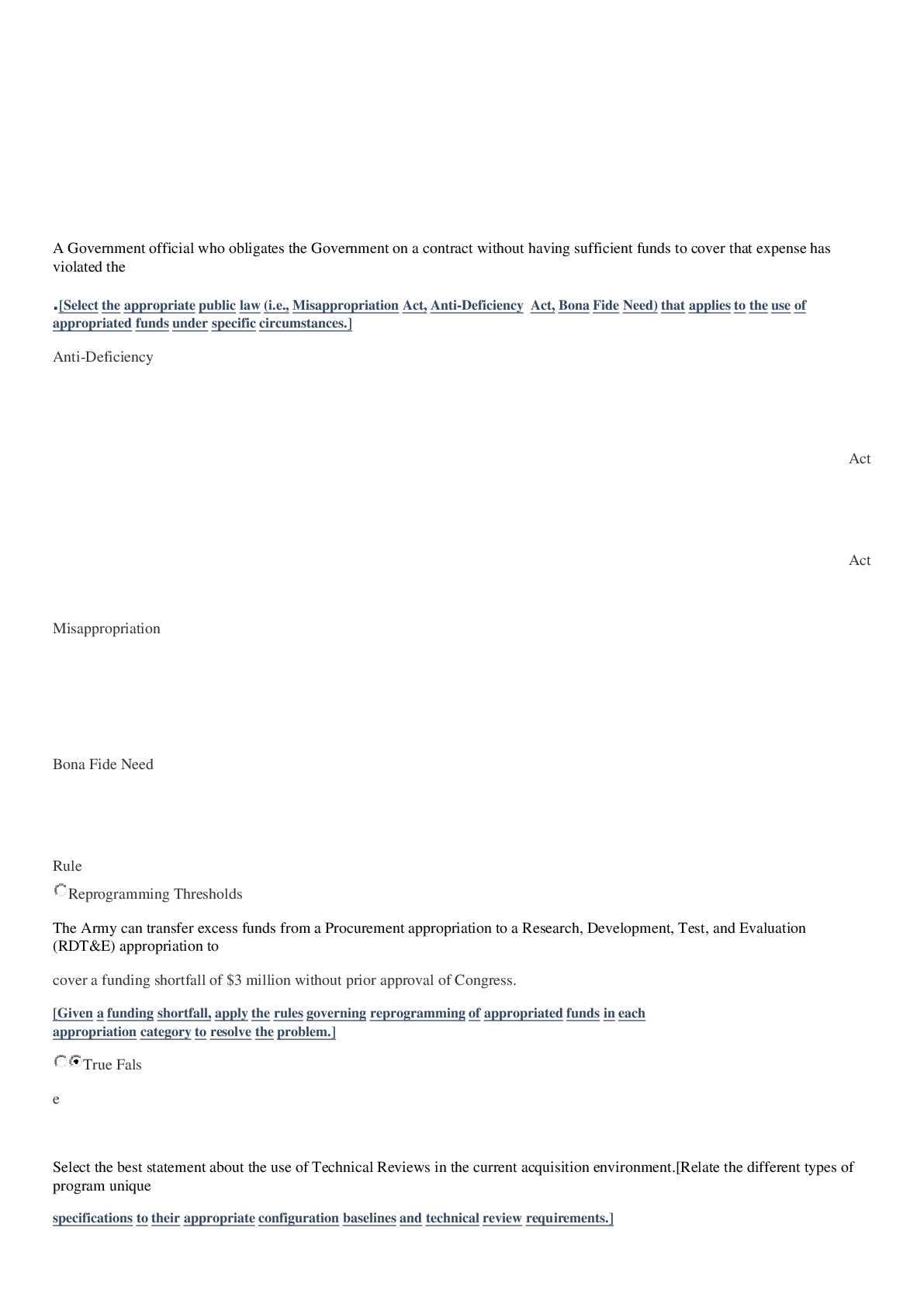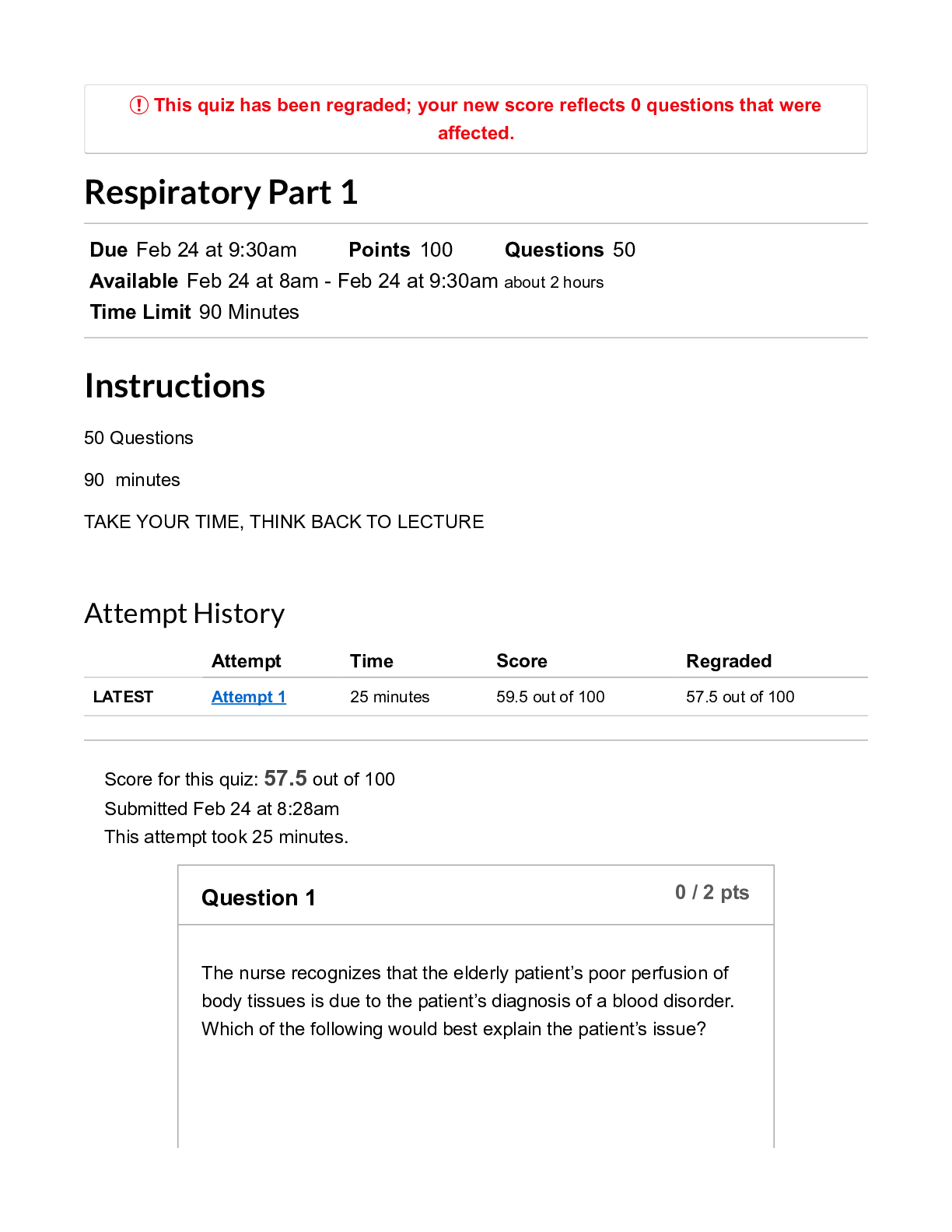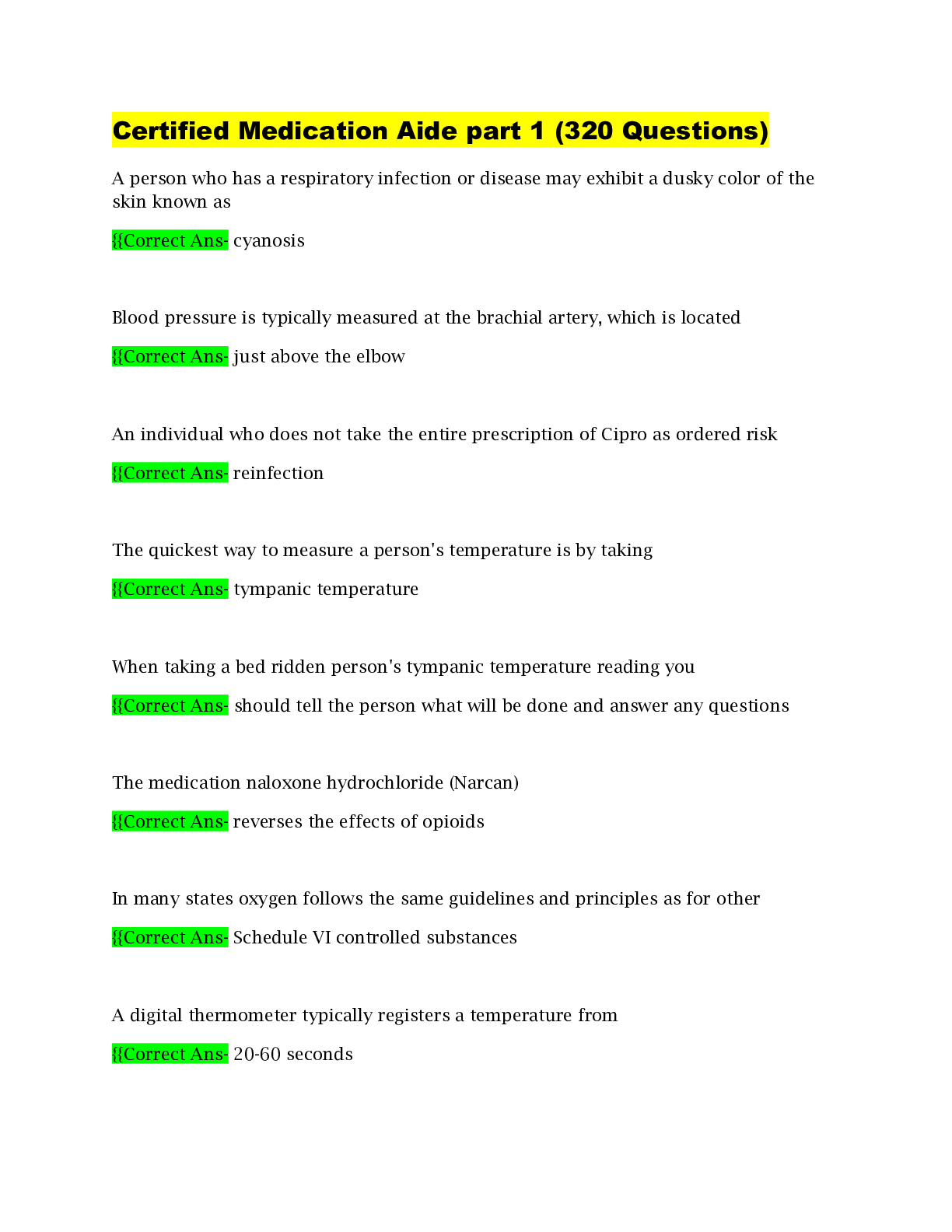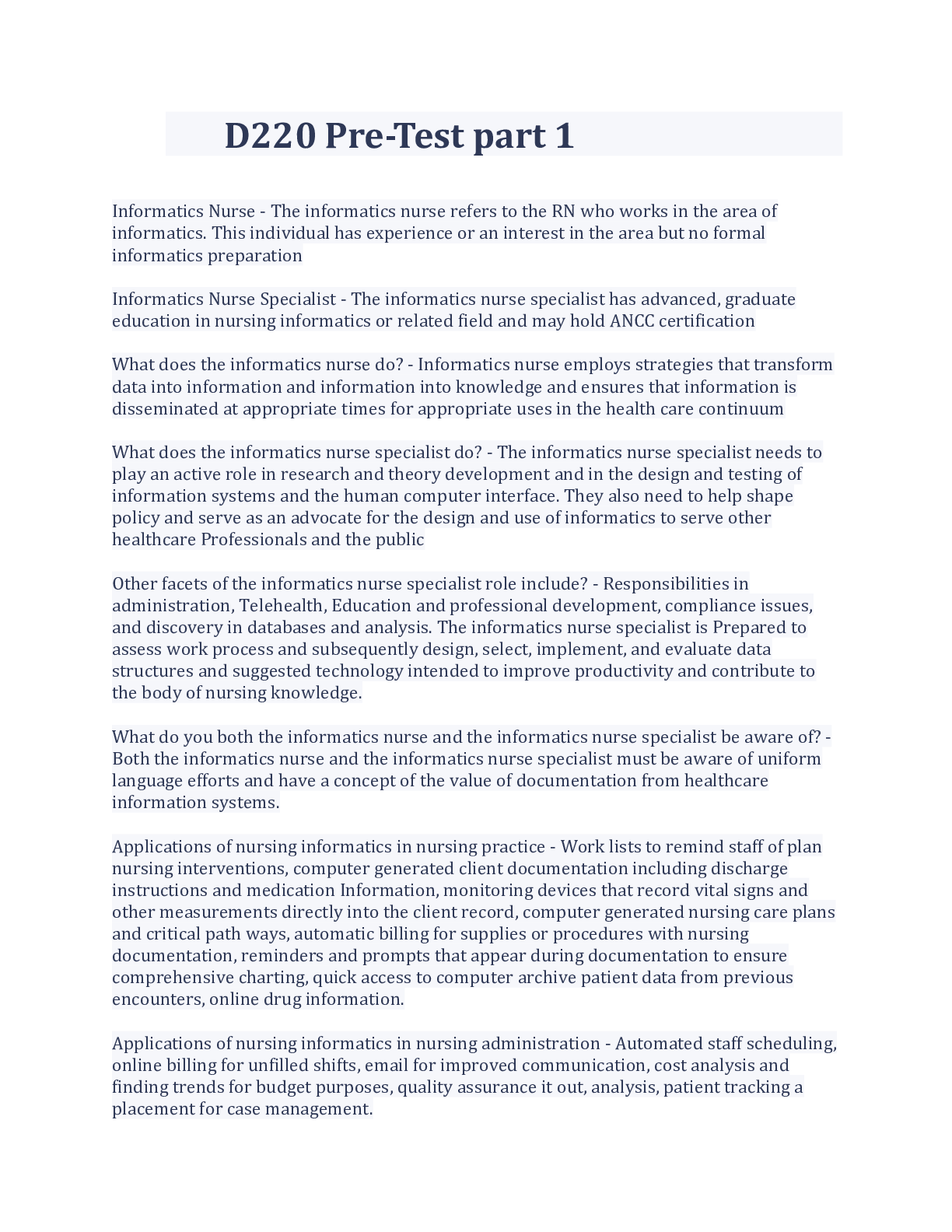*NURSING > EXAM > Arkansas State University, Newport - NURSING 213 Respiratory part 1 test (latest Spring 2021) 100% S (All)
Arkansas State University, Newport - NURSING 213 Respiratory part 1 test (latest Spring 2021) 100% Score.Already Graded A
Document Content and Description Below
Respiratory Part 1 Due Feb 24 at 9:30am Points 100 Questions 50 Available Feb 24 at 8am - Feb 24 at 9:30am about 2 hours Time Limit 90 Minutes Instructions Attempt History Attempt Time Score Regraded ... LATEST Attempt 1 25 minutes 59.5 out of 100 57.5 out of 100 Score for this quiz: 57.5 out of 100 – Corrected 100% Submitted Feb 24 at 8:28am This attempt took 25 minutes. 50 Questions 90 minutes TAKE YOUR TIME, THINK BACK TO LECTURE Question 1 0 / 2 pts The nurse recognizes that the elderly patient’s poor perfusion of body tissues is due to the patient’s diagnosis of a blood disorder. Which of the following would best explain the patient’s issue? The patient’s low red blood cell (RBC) count prevents oxygen from adhering to the membranes. The patient’s dehydration prevents circulation of free oxygen in the blood plasma. The patient’s low hemoglobin count provides less surface for the adherence of oxygen. The patient’s high white blood cell (W Question 2 0 / 2 pts The nurse is assessing the patient diagnosed with pulmonary edema and hears lung sounds, and moist bubbling sounds are heard on inspiration and expiration. What medical term best defines the sound? Stridor Crackles Wheezes Rhonchi Original Score: 2 / 2 pts Regraded Score: 0 / 2 pts Question 3 This question has been regraded. The nurse is caring for a patient with chronic lung disease who is receiving oxygen via a nonrebreathing mask. Which observation indicates to the nurse that the system is functioning as expected? Oxygen flow rate at 5L bag deflated Oxygen flow rate at 2L bag inflated Oxygen flow rate at 15L bag inflated Oxygen flow rate at 9L bag deflated Question 4 0 / 2 pts The nurse is caring for the patient who has recently recovered from a spontaneous pneumothorax. The nurse palpates the patient’s left shoulder area and feels a “Rice Krispies” presence under the skin. What best describes this symptom? It is a symptom of a pending recurrence of a pneumothorax. It is a sign that the chest tube was removed too soon. It is a sign of recovery from a pneumothorax. It occurs when air leaks into the subcutaneous tissues. Question 5 2 / 2 pts The HCP ordered azithromycin 500 mg for the first day, then 250 mg a day for 4 days for a patient with pneumonia. The pharmacy has azithromycin 250-mg tablets in stock. How many tablets will be sent to the facility for the patient’s medication? 6 0 (with margin: 0) 0 (with margin: 6) 0 (with margin: 0) 0 (with margin: 0) s s Question 6 2 / 2 pts The nurse instructs a patient with a nosebleed to sit up and lean slightly forward. For which reason does the nurse teach the patient to maintain this posture? To help prevent symptoms of shock due to blood loss To reduce bleeding from the anterior plexus To prevent dizziness or syncope To avoid unseen blood from being swallowed or aspirated Question 7 0 / 2 pts A patient is discharged from the emergency department after treatment for epistaxis. The physician orders that all home medications be continued. Which medication will the nurse question? Acetaminophen Multivitamin Penicillin Ibuprofen Question 8 2 / 2 pts A patient returns to the observation area after outpatient septoplasty for a deviated septum. Which observation will most concern the nurse? The patient’s blood pressure is 136/88 mm Hg. The patient’s moustache dressing has a 2-centimeter area of blood on it. The patient complains of tenderness in the nasal area. The patient swallows frequently. Question 9 2 / 2 pts The nurse is collecting data from a patient with a sinus infection. The patient has purulent nasal drainage, fever, and pain over the cheeks and upper teeth. Which sinuses does the nurse identify as being involved in the patient’s condition? Ethmoid Nasal Maxillary Frontal Question 10 2 / 2 pts An obese patient is being evaluated by the health care provider (HCP) for sleep apnea. Which recommendation by the HCP does the nurse find unexpected? Using a mandibular advancement device Removing excess tissue with surgery Implementing a weight loss program Using a sedative before sleeping Question 11 0 / 2 pts A patient comes to the HCP’s office reporting a serious sore throat that “has lasted for 2 weeks.” A rapid streptococcal antigen test is positive for strep throat. What test does the nurse expect to also be ordered for treatment of the patient? Identifying the exudate in the throat Antibiotic allergy testing Laboratory tests for WBC count Culture and sensitivity testing Question 12 2 / 2 pts The nurse is providing care for a patient immediately after a tonsillectomy. Which action by the nurse should be avoided? Provide the patient with warm tea sweetened with honey. Monitor the patient for bleeding and airway maintenance. Place a humidifier and suction equipment in the patient’s room. Maintain the patient in a semi-Fowler’s position. Question 13 2 / 2 pts The nurse is providing care for a patient diagnosed with influenza. The patient has a fever, chills, sore throat, and a cough. Breath sounds include crackles and wheezes. For which reason will the nurse contact the physician? The breath sounds indicate development of pneumonia. The patient is experiencing bronchial irritation from coughing. The antiviral medication appears to be ineffective. The patient needs IV fluids to loosen lung secretions. Question 14 1.5 / 2 pts A patient is demonstrating signs of pharyngitis. Which symptoms will the nurse expect to assess in this patient? (Select all that apply.) Dysphagia Sore throat Exudate in throat Extreme thirst Headache Question 15 0.67 / 2 pts A patient sees an HCP for symptoms of viral rhinitis. Which treatments does the nurse expect to be prescribed for this patient? (Select all that apply.) Rest Increase fluid intake Antibiotic therapy Decongestants Bronchodilators Question 16 0 / 2 pts A patient with chronic sinusitis that is not responsive to conservative treatment or antibiotic therapy may be advised by the HCP of what procedure for treatment? Nasoseptoplasty Rhinoplasty Sinusutomy Caldwell-Luc Question 17 2 / 2 pts Which of the following would the nurse anticipate as a intervention ordered to treat sinusitis? Mucinex to dry secretions Flonase corticosteroid nasal spray Percussion therapy to the area of infected sinus Cold dry air to reduce swelling of mucus membranes Question 18 0 / 2 pts A 42 year old female patient who states that they have smoked 1.5 (one and a half) packs of cigarettes daily since the age of 18 has a pack year number of what? 36 38 24 72 Question 19 0 / 2 pts A 56 year old male patient of African american decent is admitted to the hospital for COPD exacerbation. Upon assessment of the patient what finding would indicate cyanosis to the tissues? Pink moist mucus membranes of the oral cavity Rubor pallor to the lips Ashen pallor to the hands and feet. Capillary refill of 2 seconds to the nail beds of the hands and feet Question 20 0 / 2 pts What term would be used to describe an "extra" breath sound heart on auscultation during patient assessment? Malignant Causative Idiopathic Adventitious Question 21 2 / 2 pts This blood test measures fibrin degradation products. These are present if there is a blood clot in the body. It helps diagnose the presence of a blood clot in a pulmonary artery. D Dimer PTT Clotting Time PT Question 22 2 / 2 pts If possible, what is the optimal time of day to collect a sputum culture for testing from a patient? Upon awakening in the morning After oral care and morning breakfast has been served to the patient In the afternoons Before bedtime for the patient Question 23 2 / 2 pts What is the purpose behind the pursed lip breathing technique we teach patients? It allows the patient to inhale more oxygen with each breath Decreases the use of accessory muscles while breathing It is a distractive actiivty tothe patient's mind from the dyspnea they are experiencing It helps keep airways open during exhalation, which promotes carbon dioxide excretion Question 24 2 / 2 pts What is the most common oxygen delivery method that can be used for oxygen concentrations from 1 to 6 liters per minute? venturi mask simple mask nasal cannula bipap Question 25 2 / 2 pts A post operative patient who is at a risk for atelectasis would be encouraged to perform what activity multiple times hourly? Ambulation Deep breathing Percussion Incentive Spirometry Question 26 0 / 2 pts A patient with which of the following diagnoses would the nurse anticipate chest physiotherapy for? Cystic Fibrosis Rhinitis Subcutaneous Emphysema Asthmatic Question 27 2 / 2 pts A patient is prescribed an Acapella device to help clear secretions from the lungs. What statement by the patient indicates understanding of the device's purpose? The device is pressurized making me use extra force to move the ball inside the device. This helps me improve my end expiatory volume. Inside the device is a small steel ball in a cone shaped valve. As you exhale, the ball moves up and down, doing two things—a) vibrating your airways and b) making you exhale against resistance. This clears and loosens secretions in the lung tissue. The device delivers a small dose of dry powder medication to me. I should inhale as forcefully as I can on the device to use it properly. The device is made to remind me to take deep breaths throughout the day Question 28 0 / 2 pts What procedure involves the insertion of a needle into the pleural space. The procedure may be diagnostic to determine the source of fluid or therapeutic to remove fluid and reduce respiratory distress. Thoracotomy Chest tube insertion Thoracentesis Video-assisted thoracoscopic surgery (VATS) Question 29 0 / 2 pts If tidaling stops before the lung is reinflated, the chest tube tubing should be checked for what? If milking or stripping of the tube is needed A hole in the chest tube drainage tube Kinks or occlusions Dislodgement at the insertion site Question 30 2 / 2 pts What noninvasive positive-pressure ventilation device uses the same amount of positive pressure constantly and is maintained throughout inspiration and expiration to prevent airway collapse Mechanical Ventilation NRB mask BIPAP CPAP Question 31 0 / 2 pts What respiratory device use positive pressure to push oxygenated air via a cuffed ET or tracheostomy tube into the lungs at preset intervals? Ventilator BIPAP NRB mask CPAP Question 32 1.33 / 2 pts Which of the following would be a reason that a patient would have a tracheostomy perfomed? (Select all that apply.) Trauma to the trachea Patient who has a history of pharyngitis Patient with sleep apnea Prolonged mechanical ventilation Patient with chronic condition that keeps them from clearing secretions from airway Question 33 2 / 2 pts The nurse is assisting with setting up of the chest tube drainage system. Where would be a proper area to set the drainage device? At the end of the bed hanging from the foot board. Obtain an IV pole and clamp the device onto the pole at the same level of the bed On the floor below the level of the patient's heart Place the device in the bed with the patient to ensure it isn't dislodged Question 34 0 / 2 pts A patient with end stage lung disease is experiencing symptom of dry cough, chest pain, numbness in the extremities, lethargy and nausea. What lab value would the nurse suspect to see elevation in? C02 (carbon dioxide) pH Carboxyhemoglobin CBC Question 35 2 / 2 pts What oxygen delivery device has a reservoir bag to store oxygen for inhalation but does not allow entry of exhaled air. It is used to deliver oxygen concentrations of 70% to 100%.. Venturi Mask CPAP Simple Face Mask Non-re breather mask NRB Question 36 2 / 2 pts What oxygen delivery device is used for the patient who requires precise percentages of oxygen, such as the patient with chronic lung disease with CO2 retention. A combination of entrainment ports and specified flow rates delivers exactly the right concentration of oxygen. NRB Mask BIPAP Venturi Mask Simple Mask Question 37 0 / 2 pts The process of measuring a person’s exhaled carbon dioxide level is called what? Pulse Oximetry Pulmonary Angiography Pulmonary Perfusion Scan Capnography Question 38 0 / 2 pts A patient is diagnosed with sinusitis. How should the nurse explain this health problem to the patient? Inflammation of the pharynx, larynx, and nasal passages Inflammation of the carotid sinus Inflammation of the bony structure of the sinuses Inflammation of the mucous membranes lining the sinus cavities Question 39 2 / 2 pts The nurse is preparing to collect data from a patient with a sinus infection. Which symptoms should the nurse expect the patient to demonstrate? Facial tenderness Chest pain Hypoxemia Photophobia Question 40 2 / 2 pts A patient has a prescription for an adrenergic nasal spray to relieve nasal congestion. Which instruction should the nurse provide about this medication? “Do not use the spray for more than 3 days, or rebound congestion may occur.” “Overuse of the spray can cause hypotension; be sure to rise slowly from a sitting position.” “Apply petroleum jelly (Vaseline) to the inside of your nose if you experience irritation from the spray.” “Use the spray whenever your nasal passages feel swollen.” Question 41 2 / 2 pts A patient asks why the physician would not prescribe antibiotics for influenza. How should the nurse respond? “Antibiotics have too many serious side effects.” “Most cases of the flu are caused by antibiotic-resistant bacteria.” “Antibiotics can interact with other medications used for the flu.” “Antibiotics are not effective against viruses.” Question 42 2 / 2 pts A patient with strep throat asks the nurse why antibiotics are prescribed. What should the nurse respond to this patient’s question? “Antibiotics help prevent complications like rheumatic fever.” “Antibiotics will help you get well sooner.” “Strep throat causes high fevers that can cause neurological damage.” “Strep throat causes high fevers that can cause neurological damage.” Question 43 2 / 2 pts The nurse is admitting a patient being evaluated for suspected cancer of the larynx. Which assessment finding should the nurse anticipate? A noticeable lump in the neck A hoarse voice Coarse crackles Wheezing Question 44 0 / 2 pts The nurse is reviewing the medical histories for a group of assigned patients. Which patient is at the greatest risk for cancer of the larynx? A male patient with a history of repeated episodes of pneumonia A female patient with a history of repeated strep throat infections A female patient with a history of breast cancer A male patient with a history of alcohol and tobacco use Question 45 0 / 2 pts A patient awaiting the results of a throat culture is experiencing a severe sore throat. What should the nurse suggest to the patient to ease the throat pain? (Select all that apply.) Gargle with honey and lemon. Spray with a topical analgesic. Use throat lozenges. Sip on ice cold fluids. Gargle with saltwater. Question 46 2 / 2 pts A patient’s chest x-ray shows a suspicious area, and the physician plans a bronchoscopy. How should the nurse describe this procedure to the patient? “You will need to drink a thick white liquid that will be opaque on the x-rays.” “A dye will be injected to help visualize the structures of the bronchioles. Do you have any allergies?” “The physician will place a small tube through your nose or mouth and into the bronchi to look at your airways.” “You will be asked to use a mouthpiece to blow into a machine.” Question 47 2 / 2 pts A patient with a chest drainage system is admitted to the respiratory unit. The nurse notes vigorous bubbling in the water seal chamber of the system. What should the nurse do? Examine the entire system and tubing for air leaks. No action is necessary; this is an expected finding. Ask the patient to cough forcefully. Lower the level of suction. Question 48 2 / 2 pts A patient is making a loud crowing sound caused by an obstruction of the airways by a foreign body. How should the nurse document this patient’s lung sound? Stridor Crackle Pleural friction rub Wheeze Question 49 0 / 2 pts While providing care for a patient with asthma, the nurse notes the patient’s shoulders are rising with each breath. What should the nurse realize this action represents? Effective use of a breathing exercise to increase ventilation Hyperinflation of the chest Shoulder muscle fatigue related to difficulty breathing The use of accessory muscles to aid breathing Question 50 2 / 2 pts A patient’s oxygen saturation is 89%. Which actions should the nurse take first? No action; this is a normal oxygen saturation. Call the respiratory therapist STAT. Place the patient in a supine position. Raise the head of the patient’s bed. [Show More]
Last updated: 1 year ago
Preview 1 out of 29 pages

Reviews( 0 )
Document information
Connected school, study & course
About the document
Uploaded On
Apr 08, 2021
Number of pages
29
Written in
Additional information
This document has been written for:
Uploaded
Apr 08, 2021
Downloads
0
Views
44
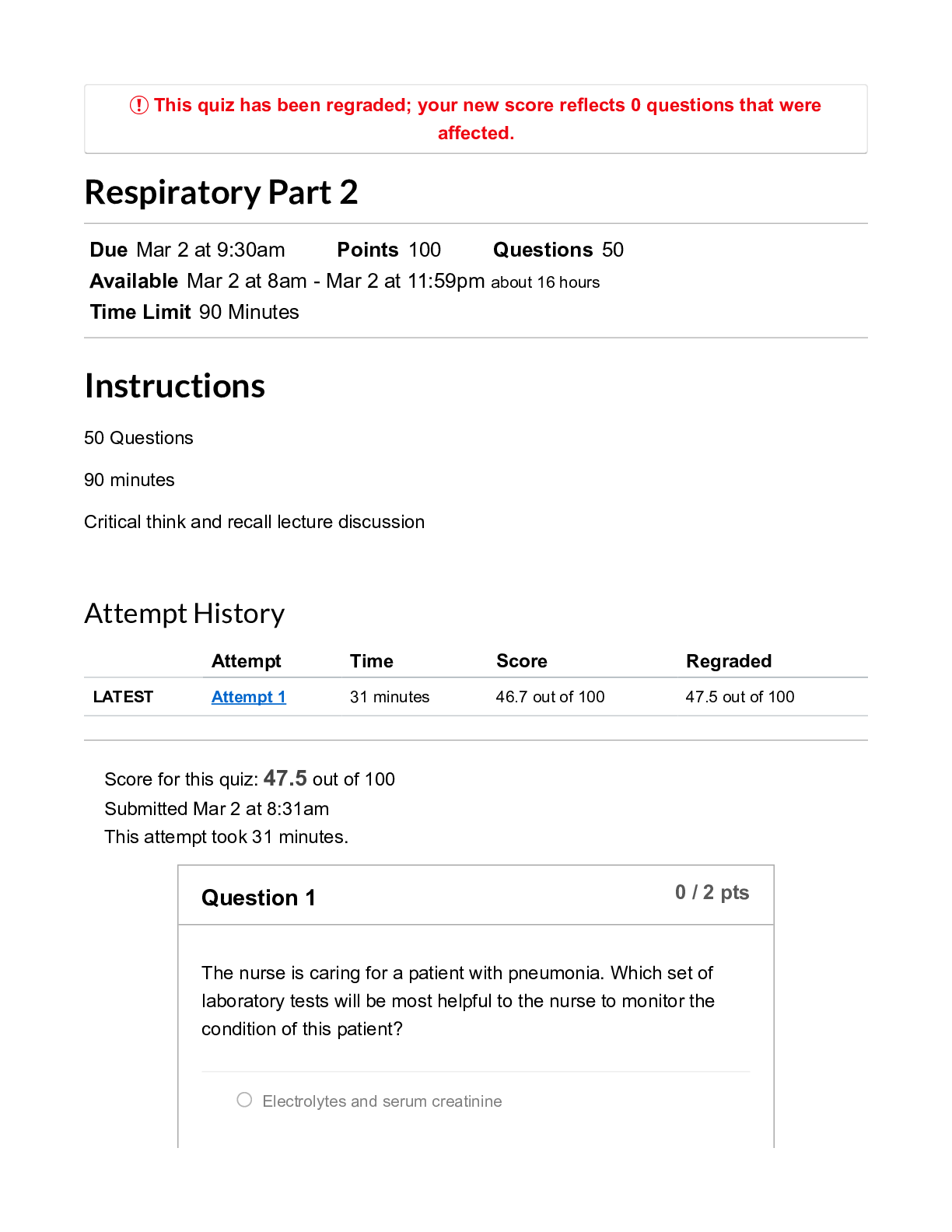




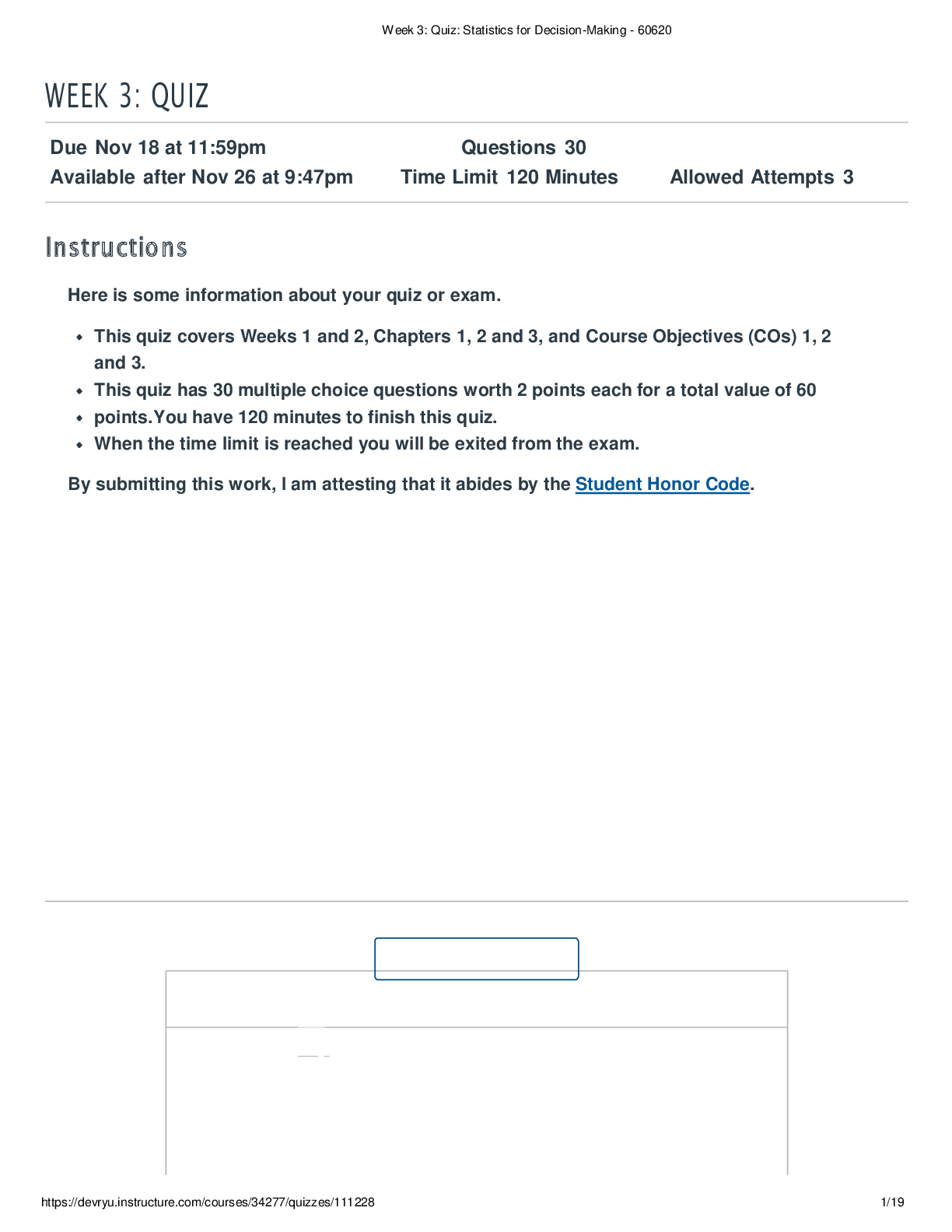

.png)










